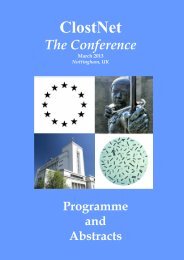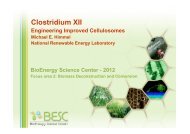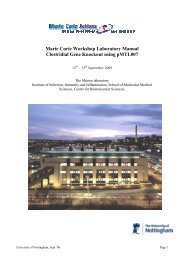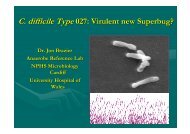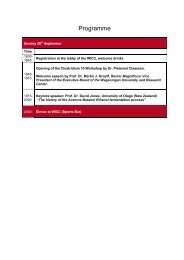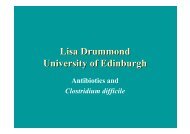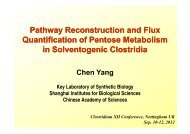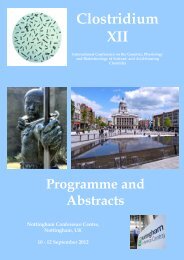abstract book - Clostridia
abstract book - Clostridia
abstract book - Clostridia
- No tags were found...
Create successful ePaper yourself
Turn your PDF publications into a flip-book with our unique Google optimized e-Paper software.
ECOLOGICAL AND FUNCTIONAL GENOMIC STUDIES FOR CONTROLOF CLOSTRIDIUM PERFRINGENS INFECTION IN BROILER CHICKENSJ. Gong and D. LeppGuelph Food Research Centre, Agriculture & Agri-Food Canada, Canadagongj@agr.gc.caWe studied microbial ecology and host response to Clostridium perfringens(CP) infection with an experimental infection chicken model. Chickens werefed antibiotic-medicated (bacitracin, 55 mg/kg) or non-medicated diets, andwere challenged with CP (107 CFU/ml) through the diets at 18 days of age.Digesta and tissue samples were collected daily before and after thechallenge, and were examined for cell proliferation of CP, gene expressionof alpha-toxin, changes in the composition of ileal bacterial microbiota, andgene expression profiles in the spleens, in addition to recording animalperformance. The cell proliferation of CP was highly correlated to alphatoxinproduction during the development of necrotic enteritis (NE). Theaverage CP counts in the ileal digesta of 5 log10 CFU/g was shown to be athreshold for developing NE disease. While major bacterial groups, such asEnterococcus genus and Enterobacteriaceae family, exhibited no change intheir populations, the abundance of lactobacilli in the ileum was significantlyreduced. In particular, the change of L. avarius correlated negatively withthe CP counts. The analysis of gene expression profiles indicated that manyimmune-associated genes were significantly up-regulated in CP-infectedchickens. These genes encode members of the Toll-like receptor pathway,antibody response, T cell markers, and inflammatory cytokines. Theexpression of a subset of functionally relevant genes was validated throughquantitative RT-PCR assays. Both medicated and non-medicated chickensdemonstrated similar annotation profiles with cell activity and regulationbeing the most dominant biological processes across time. We also had aseparate effort to identify novel C. perfringens virulence factors in NEpathogenesis through the analysis of the genome sequence of an isolateknown to cause NE disease in broilers. Genome comparison with other nonpoultrystrains revealed a number of putative genes unique to this isolate,including a putative hemolysin, a capsule biosynthesis locus, and severalantibiotic resistance genes. We are developing a microarray based on thisstrain, which will be used to further identify and characterize genes related toNE disease. Key words: chickens, Clostridium perfringens, microbiota,immune response, pathogenesis



